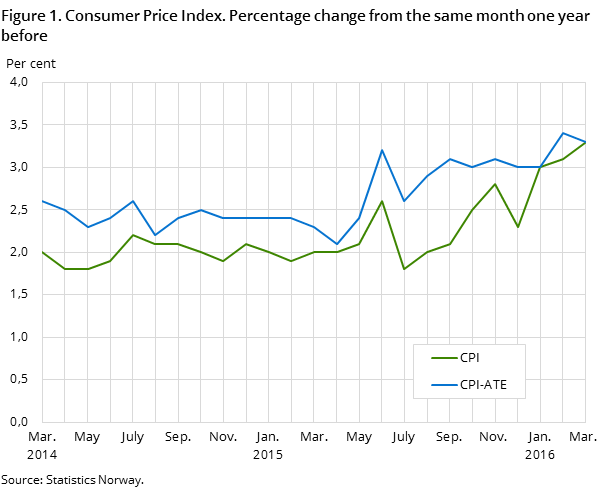Content
Published:
This is an archived release.
Increased transport prices
The Consumer Price Index (CPI) rose 0.5 per cent from February to March, mostly due to higher transport prices. The year-to-year growth in the CPI was 3.3 per cent in March, up 0.2 percentage points from February.
| Monthly change (per cent) | 12-month rate (per cent) | Index | |
|---|---|---|---|
| February 2016 - March 2016 | March 2015 - March 2016 | March 2016 | |
| CPI All-item index | 0.5 | 3.3 | 143.4 |
| Food and non-alcoholic beverages | -3.2 | 1.4 | 131.4 |
| Housing, water, electricity, gas and other fuels | 0.6 | 3.0 | 175.6 |
| Transport | 2.5 | 3.9 | 155.9 |
| Recreation and culture | 0.3 | 4.6 | 126.9 |
| Clothing and footwear | 3.7 | 4.7 | 56.0 |
| CPI-ATE (july 1999 = 100) | 0.3 | 3.3 | 134.1 |
| CPI by delivery sector | |||
| Consumer goods | 0.2 | 3.3 | 103.9 |
| Services | 0.7 | 3.5 | 104.1 |
| Services where labor dominates | 0.2 | 2.6 | 104.1 |

The year-to-year CPI-ATE growth was 3.3 per cent in March. The CPI was 143.4 (1998=100) in March 2016, compared to 138.8 in March 2015, which corresponds to a year-to-year growth of 3.3 per cent.
Monthly change: rise in airfares and fuel prices, lower food prices
The CPI increased 0.5 per cent from February to March. The main factor was a 17.2 per cent increase in airfares. This increase is higher than usual for this period, and comes on top of a similar price increase from January to February. These two price increases pushed up the index on airfares to its highest level ever. The increase in airfares in March must be viewed in conjunction with Easter falling in March this year, resulting in a higher load factor than the previous month.
Fuel prices went up in March after several months with a decrease. Prices on auto diesel rose 8.3 per cent; the highest monthly change since November 2007. Petrol prices increased 3.9 per cent from February to March. Increased prices on parking also contributed to the transport index rise of 2.5 per cent last month.
The group with furniture had a price increase of 6.6 per cent. Prices in this group normally increase in March after the yearly January sales. Prices of clothing also normally increase from February to March, due to the final sales on winter clothes and arrival of spring/summer collections in stores. These two groups are important in the delivery sector imported goods excluding agricultural products, which went up 1.3 per cent last month.
Easter impacted prices of food and non-alcoholic beverages this year, with huge price cuts on selected items. All groups showed a price decrease, the largest being registered for “sugar goods”. Sub-groups containing typical “Easter” goods, such as citrus, chocolate, root vegetables, bacon, ketchup/mustard, eggs and hot-dog buns, had large price cuts. The combined price decrease for food was 3.3 per cent in March, the highest price decrease in a single month since the VAT was adjusted in July 2001.
The increase in the CPI was also dampened by a price decrease in non-alcoholic beverages, beer and products for home cleaning.
Year-to-year growth: higher airfares and electricity prices
The CPI rose 3.3 per cent from March 2015 to March 2016. Higher airfares were the largest contributor to the year-to-year growth. Airfares in March this year were 41.1 per cent higher than in the same month last year.
Prices on electricity including grid rent had a year-to-year increase of 10.4 per cent. Electricity prices have increased the most, but the grid rent has also increased much more than the rise in the general CPI.
Prices of imported goods excluding agricultural products have gone up 4.2 per cent over the last twelve months, mainly driven by price increases of 5.1 and 8.4 per cent on clothing and furniture.
The year-to-year growth in the CPI was mainly dampened by lower fuel prices. Fuel prices have now experienced a negative year-to-year price increase for 19 consecutive months.
Change in the year-to-year growth: electricity prices pulled the growth rate up
The year-to-year growth in the CPI increased from 3.1 per cent in February to 3.3 per cent in March. The increased growth rate was mainly due to the development in prices of electricity and airfares. Prices of electricity including grid rent increased 2.3 per cent from February to March this year, while falling 3.8 per cent in the same period last year. Airfares rose 17.2 per cent from February to March 2016, compared to a rise of 3.3 per cent in the same period in 2015.
The price development of food and non-alcoholic beverages pulled the growth rate in the opposite direction, as prices fell more from February to March 2016 than from February to March 2015.
The year-to-year growth in the CPI-ATE was 3.3 per cent in March, down 0.1 percentage point from February.
New detailed consumer classification, ECOICOPOpen and readClose
The CPI adopted Eurostat’s new detailed 5-digit consumer classification, ECOICOP in January 2016. Statistics Norway has published unofficial 5 and 6-digit COICOP indices for the consumer group Food and non-alcoholic beverages up until January 2016. As a result of a discrepancy between the unofficial and the new official ECOICOP, some previously published indices are no longer available. This results in new names for some of the published groups.
Contact
-
Statistics Norway's Information Centre
E-mail: informasjon@ssb.no
tel.: (+47) 21 09 46 42
-
Konsumprisindeksen
E-mail: konsumprisindeksen@ssb.no
tel.: (+47) 62 88 56 34
-
Camilla Rochlenge
E-mail: camilla.rochlenge@ssb.no
tel.: (+47) 40 90 23 72
-
Kjersti Nyborg Hov
E-mail: kjersti.nyborg.hov@ssb.no
tel.: (+47) 40 90 23 63
-
Gunnar Larsson
E-mail: gunnar.larsson@ssb.no
tel.: (+47) 40 90 26 79
-
Trym Kristian Økland
E-mail: trym.okland@ssb.no
tel.: (+47) 46 81 09 15
